
What Is A Sales Funnel And How To Build A Profitable One For Your Business [2025]
Sometimes you may feel you’ve tried everything to turn prospects into paying customers—except a magic wand. But here’s what will do the work for you: a well-structured sales funnel.
Today, we’ll help you build your own funnel by showing you all you need to know, from picking the most suitable content types for each stage to measuring and optimizing your performance.
And since there’s no one-size-fits-all in business success, we’ll also share some alternative ways to reach growth—and your audience.
Need the perfect tool to start building the ultimate sales funnel and turn your audience into loyal advocates? Try Moosend to capture leads with beautiful landing pages and nurture them with valuable email campaigns.
Turn visitors into customers
Captivate leads with Moosend’s premade forms and landing pages.
Start FreeWhat Is A Sales Funnel?
A sales funnel is a business model that consists of all the necessary steps that a prospective customer has to take to become a loyal brand advocate. In essence, it maps out the customer journey, dividing it into four stages: awareness, interest, decision, action, and retention.
Compared with a marketing funnel, where the goal is to attract and engage customers, a sales funnel focuses on leading prospects to action.
Why Do You Need A Sales Funnel?
Nothing is random when it comes to the buying process. From the moment your potential customer finds out about your business to the time they make their Xth order, you need to pay close attention to their behavior.
An effective sales funnel helps marketers visualize and understand the customer journey. On top of that, you can use it to:
- Deliver the right content and offer to each prospect, aligning your sales efforts with the information they need throughout their journey
- Identify the most effective marketing channels and initiatives to guide your audience towards purchasing
- Create relevant messages and perfect your timing to increase conversions
- Find weak spots in your marketing plan and come up with viable solutions to serve your audience better
Simply put, your end goal is to influence decisions at every step of the conversion funnel.
Before going through the ‘how’, let’s break down these steps first.
The Stages Of A Sales Funnel
First of all, when we look at a sales funnel, we see three broader categories:
- Top of the Funnel (ToFu)
- Middle of the Funnel (MoFu)
- Bottom of the Funnel (BoFu)
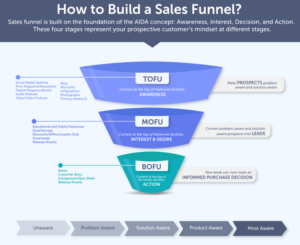
Marketers use this scheme to create a focused content marketing strategy for their new leads. For instance, when prospective customers discover your brand, they’re initially at the top of your funnel. Therefore, you need to deliver ToFu content like guides, videos, or eBooks to get them interested in your value proposition.
To give you a hand, let’s take a thorough look at the sales funnel stages and what types of content are ideal for each stage:
Awareness Stage
This is the moment when consumers discover your product/service. Awareness isn’t limited to your value proposition, though. During this phase, people might become aware of a pain point they have and look for ways to solve it.
How will they find your business? Perhaps they stumble on your social media content (posts, Facebook Ads, etc.) or discover your offerings through a Google search. It might even be with the power of word of mouth.
In this funnel stage, you want to drive the new lead into the sales process by capturing their attention. If your offer is good enough, they’ll enter the sales funnel and start searching more about your business.
Best content type to use
To engage your target audience, you need valuable content. Here are the best types you can use:
- SEO-optimized blog content
- Social media posts
- Infographics and e-books
- Videos and podcasts
- White papers
Interest Stage
During the interest stage, consumers are aware of their needs and pain points. However, since they aren’t sure about the solution, chances are they won’t make a purchase. Instead, they will conduct research to find the best fit.
So, if you want to turn these consumers into sales-qualified leads, you need to show them what they’ll gain from investing in your offering. While it might take time to get them to the next stage, you and your salespeople should monitor these interest-stage leads to avoid losing a great opportunity.
Best content type to use
This is where you must make sure to show your field expertise and target qualified leads with educational and helpful content:
- Lead magnets like eBooks, templates, checklists, etc.
- Comparison posts, videos, etc.
- Lead capture landing pages
- Webinars
Decision Stage
In this sales funnel stage, your leads have narrowed down their options, and they’re now ready to decide. Still, they have more than one solution in mind, so this is when they usually dive deeper. For example, explore each product’s or service’s pricing.
Now it’s time for you to play your cards well and lead them towards your product/service. You can entice leads to make a decision through unique discounts, free shipping, or gifts.
Best content type to use
Here, you need to deliver content that gives your leads more reasons to convert into paying customers. Here’s what you should offer them:
- First-time purchase discounts for eCommerce stores
- Email newsletters with reviews and testimonials
- Engaging explainer videos
- Targeted offers
For example, creating testimonial-infused email campaigns is an effective method to show potential customers how your product/service helped their peers. Which, in turn, increases your credibility and builds trust with new prospects.
Just like Peloton does in this campaign full of enthusiastic reviews from happy customers:

To create such a campaign (and any other email type you can think of), choose one of the pre-designed email newsletter templates that Moosend offers. After signing up, just hop into the editor and tailor it to your branding and campaign goal.
Action Stage
Now your leads are probably ready to buy. But it’s possible that something gets in the way. They might experience an inconvenience like a family emergency. There’s also a chance they’re having second thoughts.
To persuade them, you need to keep nurturing your audience with personalized messages. Also, don’t forget to use urgency to make them click on your calls-to-action. Another key ingredient is stellar customer service that encourages action.
While a great offer might be enough to do the trick, don’t forget to address your potential buyer’s pain points. Remember, they’re already convinced, so focus on content that highlights how your products/services will help them accomplish something important.
Best content type to use
To close the sale, make sure to customize your sales funnel messages and provide unique customer experiences. You can do it through:
- Personalized email marketing campaigns
- Landing pages with irresistible value propositions
- Free trials and demos
- Sales calls
Retention Stage
If your audience reaches this stage, you have successfully managed to get them on board. Congrats! However, your job isn’t done. Quite the contrary, this might be just the beginning.
The retention sales funnel stage is as important as the purchase stage. Statistics back this up since customers have a 27% chance of coming back after their first purchase. And this number may reach up to 49% or 62% after they make a second or third purchase, respectively.
So, we’ve established that retention is more profitable than acquisition. But it’s not like you don’t have to work equally hard just because you already have their attention.
To turn new customers into recurring buyers, investing in a solid customer retention strategy is crucial to ensure they’ll stick around.
Best content type to use
To hack retention, consider using the following:
- Email newsletters with tips/how-tos
- Special offers for recurring customers
- User-generated content featured in different touch points (e.g., website, social media)
- Loyalty rewards
Now, let’s see a funnel example to help you identify a winning sales process. As a bonus, we’ll check out a real-life example from a popular brand.
What Does A Successful Sales Funnel Look Like?
Let’s say you run an eCommerce business that sells hair products for women. After thorough research, you’ve identified your ideal buyer persona: females between 30 and 50 in search of quality products for thinning hair.
Awareness: You’ve found that this buyer persona uses Facebook to search for beauty tips. So, you decide to create a Facebook lead ad that will bring them to a quiz on hair health to grab their attention.
Interest: When they click, they’ll visit a landing page with the quiz. Once they complete it, you’ll offer them a free hair care guide tailored to their pain points. To get it, they’ll have to fill in their email address.
Decision: Now they’ve joined your email list. Well done! After segmenting them based on their answers, you’ll start delivering email with personalized content:
- Useful tips about hair care routine
- Short video tutorials
- Customer reviews
Purchase: You nurture new subscribers for a while before sending a first-time 10% discount on a product bundle. Perhaps even make it a limited-time offer to create urgency and prompt quick action.
Retention: Of course, your job doesn’t stop there. Now your goal is to target new customers with post-purchase content, starting with a thank-you email after the purchase.
Down the line, you can automate a post-purchase email sequence to keep them engaged. In the first email, share instructions on how to make the most of the product. Then, use the second one to target them with cros-sell suggestions for even better results.
This is how a well-built sales funnel works, allowing you to turn a visitor into a loyal customer. Now let’s take a look at how Starbucks does it.
How Starbucks Sales Funnel Works
We all know Starbucks. Perhaps we’ve even grabbed one of their drinks once—or twice, or… Starbucks reaches different audienceσ through a combination of marketing tactics, ranging from social media ads to TV commercials.
On their website or mobile app, users can view the menu, order a customized drink, and sign up for their Starbucks Rewards system. To encourage initial purchases, they offer a free drink to people who join their loyalty program:
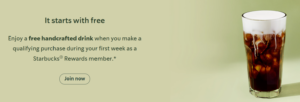
They also target people who have received a gift card with a “2 stars per dollar” offer. Another clever way to promote their loyalty program. When consumers purchase, whether in physical locations or online, they earn stars and rewards.
Customer retention is where they truly excel, investing in a range of online and offline tactics:
- Using push notifications for personalized product recommendations and limited-time offers
- Promoting new menu additions and cross-selling items in-store (“Would you like a cookie with your drink?”)
- Sending emails to promote seasonal products or offer exclusive access to contests with unique prizes:
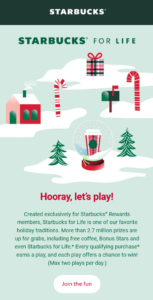
How To Create A Profitable Sales Funnel
Now that you know what a successful sales funnel is and how it looks, here are 8 easy steps to build your own:
1. Get to Know Your Audience
First of all, you need to start with the right data. Meaning you must collect enough information to identify your prospective customers. The more data you have on them, the more successful your sales funnel will be. Some of the easiest ways to gather customer data are to:
- Send customer surveys
- Monitor website analytics
- Analyze customer service feedback
- Create newsletter signup forms
- Conduct keyword research
- Use quizzes and polls in emails and social media
- Research your competitors’ target audience
- Ask for feedback in-store (if you have an offline presence)
But what kind of information do you need? Try to collect data on your prospects’ needs, pain points, aspirations, preferred marketing channels and content types, and purchase behavior. Also, if possible, try to find out which products/services they’ve used to solve similar pain points.
You collected the data. Now what? You’re on your way to narrowing down your audience. After all, marketing your value proposition to everyone is bad practice. So, you should use the info to create and improve your buyer personas. Plus, identify lookalike audiences and optimize your offerings.
2. Build High-Converting Landing Pages
Let’s say you want your prospects to sign up for a free trial, grab an offer, or download a resource. Once they do, you’ll probably direct them to a landing page. If this is their first interaction with your brand, you should nail this first impression.
The ultimate goal is to capture your audience’s attention—and their email addresses. Or any other information you deem useful to target them effectively. Therefore, always keep this in mind: you want to access valuable data, not get salesy.
So, how do you create efficient landing pages for your sales pipeline?
- Highlight the benefits of your value proposition
- Write eye-catching landing page copy, focusing on your core message
- Use a prominent CTA button that clearly communicates what you want users to do
- Include high-quality visuals of your products
- Don’t ask for too much information right away
- Add social proof (customer testimonials, star ratings, etc.)
- Create a frictionless experience for all users (hint: optimize for mobile devices)
Basecamp’s landing page ticks all the boxes: a prominently-placed CTA, a helpful downloadable resource, and a token of social proof. Plus, they included several positive customer reviews to build trust right off the bat.

If you need more inspiration, don’t forget to check our carefully curated list of landing page examples.
3. Offer Value Upfront
There’s another key point involved in effective lead generation. And that’s giving consumers something they want. If they know almost nothing about your brand, piquing their curiosity might be the perfect starting point. If they’re already interested, it will show them you aren’t just going for the sale.
Whether it’s a landing page or a signup form, make sure you add an irresistible offer. Given that you’ve done your homework during the first step, you’ll have an idea of what could interest them.
Your offer may come in the form of a lead magnet, such as an eBook, template, or whitepaper. Another common practice is to give them a coupon code or discount in exchange for their information. It might even be a free trial, so they can try out your value proposition without making a commitment.
While giving away something of value works perfectly well, you can always make the offer more effective. How? By creating a sense of urgency. Just like Moosend did in the following pop-up during a Christmas promotion. They added a 36% discount on annual plans, highlighting the time left for claiming it.
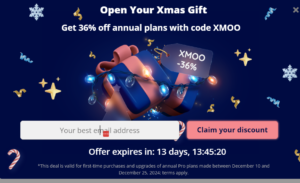
4. Nurture Leads with Valuable Content
Now that you have their email addresses, what’s next? Well, it turns out that 28% of consumers back out of deals because they’re not convinced that the product/service is the right choice for them.
So, this is when (and why) you should use email marketing to nurture new subscribers with educational content. Think of anything that could guide them on how to make the most out of your products/services:
- Lists with tips for those leads who prefer to get started fast
- Detailed how-to guides and product demos that help users understand how your offerings meet their needs
- Case studies to show them how other customers reached the desired results using your value proposition
The key is to share persuasive content that nudges them towards taking the next step.
Sure, you can always throw in a special discount to convince them. But make sure they truly know why they need your products first.
Apart from emails, social media ads and webinars could also serve as engaging content that informs and educates leads until they’re ready to buy.
Once you’ve got them all warmed up, you can send them more targeted offers and recommendations to build up the sale.
5. Use Automated Workflows
You might wonder: “How will I target each subscriber with the right message at the right time?” The short answer is: through email automation. With it, you map out the customer journey all the way from subscription to loyalty and tailor conversations accordingly.
For example, you shouldn’t target someone who just signed up with an upsell email. Instead, you should send a beautiful welcome email to make a great first impression and introduce them to your brand.
Email automation serves you in a range of occasions, ensuring timely and relevant content that moves leads down your sales funnel. Let’s check them out:
- Birthday, anniversary, and milestone emails to send wishes and perhaps some kind of gift
- Abandoned cart email series with special incentives to persuade users to complete their orders
- Feedback requests after purchase to ask about their experience
- Upselling and cross-selling offers, urging people who have already purchased to spend more
- Promotional sequences with limited-time offers and discounts to convert recipients into first-time shoppers
- Re-engagement emails to bring dormant customers back using customer reviews, personalized product recommendations, and product launches/upgrades
- Customer loyalty emails to reward loyalty program members with first-access to new products or exclusive deals and content
To make email automation a breeze, invest in an email tool like Moosend, offering a range of functionalities like audience management, pre-designed automation recipes, a multitude of trigger points, if/else logic, and split flows.
Also, you can integrate the platform with a variety of CRM tools to have as many customer data as possible to refine segmentation and personalization.
This way, you’ll manage to deliver the right message to the right person at the right time! All you need to do is create a Moosend account and get started with email automation today.
Below, EXOH uses a re-engagement email to promote its lip balm series. Besides the clever email copy and casual style, they make sure to lure subscribers in with an eye-catching CTA, social proof, plus free shipping on orders above $25.

6. Always Follow Up with your Audience
Your sales efforts don’t end with a “no”. They don’t end with a “yes” either. It’s not uncommon for people to exit your sales funnel without prior notice. This doesn’t mean you should leave things to chance.
To build a pipeline that will perform, you need to keep the spark alive, and your audience engaged. A consistent email schedule will help you deliver thoughtful follow-up messages.
If you closed the deal, start by sending a thank-you email. To make them feel cared for after the sale and encourage product adoption, consider sharing tips and tricks on how to use it effectively.
Or take a different approach and leverage the occasion to remind them of your vision, just like Homes Alive did:

Do you have fresh blog content, important updates, or industry news to share? Then, ensure they’ll be the first to know and have access to them, e.g., early-bird tickets for upcoming events.
This kind of regular and helpful communication increases the chances of keeping them at the bottom of the funnel instead of letting them exit it.
With the right incentives, you could turn them into returning customers. And let’s not forget that a positive post-purchase experience is perhaps the number one motive for customers to recommend your products/services or giving you a great review.
Apart from sending emails, you can also leverage your social media channels to approach your audience. Create beautiful posts, reply to their comments, and solve their problems through direct messages. As a result, you’ll achieve multichannel engagement and offer potential customers a better experience.
Last but not least, keep the conversation going through excellent customer support at every step. Having a responsive customer service team and detailed documentation to address issues early is key to customer retention.
7. Measure Success
To keep your sales funnel effective, you need to constantly track important marketing metrics. By doing so, you can tell which aspects of your strategy are working and where you should be making tweaks.
Here are the most significant indicators:
- Session duration: The time a visitor spends on your website during a single visit
- Leads entered: The number of leads you gained and from which channels they entered your funnel (email, social media, Google search/Ads, etc.)
- Cycle duration: How much time it took them to move to the next stage
- Customer acquisition cost (CAC): How much it cost to acquire new customers
- Customer lifetime value (CLV): The net profit expected from each new buyer
- Conversion rate: How many converted into leads, and how many leads into paying customers
To gather all the information you need, you’ll need to collect insights from different sources, starting from your website analytics and moving on to social media reports and key email metrics.
Once the data is in, analyze them carefully to detect bottlenecks in your sales funnel and optimize the process. For instance, if you see that people visit your landing page but don’t fill in their information, perhaps you ask for too much data. Or it might be that you need a stronger incentive.
Also, if you notice that your sales funnel doesn’t bring the outcome you expected, you should run various A/B tests to check what works and what doesn’t.
8. Optimize Your Sales Funnel
Measuring your sales funnel performance brings us to the final step: optimizing it for better lead generation and conversions. Building a sales funnel isn’t a set-it-and-forget it strategy. Instead, it’s a dynamic tool that you must adjust based on changing trends and audience behavior, and your evolving value proposition.
If you notice that your sales funnel is underperforming, it could be because of these common culprits:
- You aren’t targeting the right audience
- Your content isn’t engaging enough or doesn’t match the prospect’s stage and needs
- There are friction points during checkout/subscription
- You reach out too late or too soon
- You don’t follow up effectively
To optimize your funnel, you need to address these problems and find ways to simplify the customer journey. Here are some simple ways to achieve it:
- Improve your website CX to reduce friction
- Leverage referrals to boost lead generation and broaden your reach
- Use retargeting campaigns to capture visitors
- Set up automated workflows for different scenarios to send laser-focused content
- Add social proof elements (like case studies or testimonials) to your product pages, social media, and emails
- Monitor subscriber engagement to find out the best time to send your campaigns
- Revisit your content marketing strategy to create content that matches each persona’s intent
- Train your sales reps to be up-to-date with current customer behavior patterns
- Involve your customer support team to optimize onboarding
- Spy on your competitors to find tactics that work and that you haven’t implemented yet
But you can’t do everything on your own. You need the right tool to manage your contacts, personalize your messages, automate tasks, and track KPIs.
Moosend is a robust email marketing automation platform that allows you to build compelling signup forms and landing pages, segment your audience for better targeting, and use automation to send timely messages.
Using the Principles Of Influence For Better Sales
Of course, to get your leads from one stage of the sales funnel to the next, you need to find ways to influence them positively.
Coming from the “godfather” of influence himself, Robert Cialdini, let’s take a look at the six principles of persuasion you can leverage to move your customers a step further down your funnel:
Reciprocity
To use reciprocity, you have to show your leads the value of your business through unique customer experiences and excellent products. The more you keep them satisfied, the more they will invest in your business.
A simple example of reciprocity is offering your audience a gift or discount, either through your landing pages or online forms. As a result, your prospects will give you their contact information in exchange.
Scarcity
Having a great product that sells more is, of course, what every business wants.
Well, what if I told you that consumers are more likely to buy something when it’s scarce? Offering a limited amount of items will influence them to get it no matter what. Why?
Due to the fear of missing out (FOMO) on an incredible experience. To use this principle in full, don’t forget to highlight the benefits your potential buyers will gain by purchasing from you.
Authority
In the era of phishing and scamming, customers need to find credible products to satisfy their needs. To be under their radars, show them that your business is credible and reliable.
Establishing authority in your niche is essential to convince and convert your target audience. So if you have the knowledge and expertise, don’t forget to leverage every opportunity to showcase it.
Commitment or Consistency
Commitment plays a major role in increasing your sales. By getting your new customers to commit to your brand, you’ll slowly manage to offer value and turn them into loyal supporters.
Of course, to make the most of this principle, you have to be consistent with your messaging and live up to your promises. The more honest you are, the easier it will be to convert them.
Liking
The consumer/brand relationship has changed dramatically over the years. As a result, customers usually turn to brands they like and trust.
To build that connection, you need to create incredible stories that will humanize your business and make it feel relatable. By using the principle of liking, you can encourage your audience to act and stick around.
Social Proof
Before they purchase your product, potential buyers will first look at customer testimonials to decide whether you’re worth their time and money.
Uncertainty can be a major obstacle, especially if you’re new to the eCommerce or retail game. Nevertheless, using social proof will help you approach new leads and make them trust you before they purchase. And all these thanks to the power of a few positive reviews and social media posts.
We’ve gone through everything sales funnel-related. But we couldn’t claim that this is the Holy Grail of business growth. So, let’s check out a few alternatives.
Are Sales Funnels Still Effective?
Sales funnels have been around for a long while. Perhaps too long. In fact, the concept goes back in 1898. And it was created with linear customer journeys in mind. But the modern journey is anything but linear—most of the times.
Audiences nowadays may jump from awareness to purchase right away, skipping steps or even going backwards. Plus, their journey consists of several, multichannel interactions.
This is why some marketers prefer to invest in more dynamic models that involve complex and unpredictable paths rather than guiding prospects from point A to point B. So, let’s explore some flexible sales funnel alternatives to understand customer behavior:
1. Product-Led Growth
Product-led growth (PLG) is a growth model that counts on the product to do the promotion and selling. Investing in the self-service principle, brands create products that everyone can access and try out before purchasing.
This is extremely helpful, especially in the SaaS industry where busy professionals need product solutions that they can easily adopt and have control over. Most importantly, without the need for intermediaries and long sales processes.
Basically, users sign up for the product’s free version or trial and explore its functionalities. This business model relies heavily on user onboarding, so they have all the help they need to reach the tool’s full potential.
Once they discover its value, they might choose to upgrade to get the most of it. And they can do so on their own, meaning that businesses will spend less on customer acquisition.
Moosend, Slack, Grammarly, and Airtable are just a few of the companies using a product-led strategy to promote their offerings.
2. The Flywheel
The Flywheel is a framework that puts the customer at the center of a brand’s strategy. Every team member aims at delivering an impeccable customer experience.
And then happy customers act as the drivers of growth, helping the brand make sales through repeat purchases and positive word of mouth. So, instead of allocating your resources in bringing more customers in, you focus on keeping existing customers satisfied so they attract new prospects.
In this model, sales, marketing, and customer service teams work together to identify engagement opportunities that move the wheel faster. Also, to detect and reduce friction points in the customer experience to increase overall satisfaction.
Airbnb is a successful example of the Flywheel model. By giving travellers the opportunity to become hosts, they create a powerful network that sells, purchases, and promotes at the same time.
3. Relationship-Led Growth
Relationship-led growth is a strategy that invests in relationships to drive the desired business outcomes. It involves forging deep and mutually beneficial connections with key stakeholders, such as partners, colleagues, investors, and customers to unlock business opportunities.
This model treats every interaction with different stakeholders as an opportunity to collect valuable audience insights and expand your reach through referrals, collaborations, and internal advocacy.
For instance, you can create bundled offers or run joint webinars with partners. Or let your employees share news and updates on LinkedIn to attract and engage customers. Basically, every relationship could turn into a growth channel and every stakeholder into a brand ambassador.
Build A High-Performing Sales Funnel
From small businesses to large enterprises, creating a sales funnel helps you increase your revenue and ensure the survival of your business.
Knowing about the stages of your funnel will help you understand the customer journey and deliver content that will turn your leads into paying customers.
What’s more, with the right strategies, you can set up a profitable funnel that will perform. But first, make sure you get all the right tools for the job. Signing up for a Moosend account will help you capture, nurture, and convert those customers effortlessly.
Now it’s time to let your sales funnel work its magic!
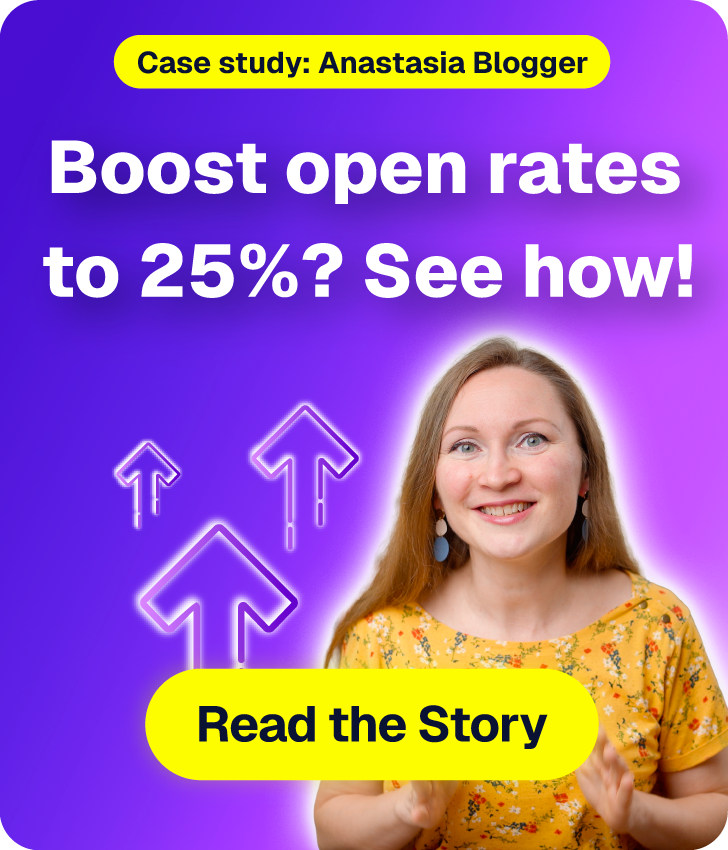
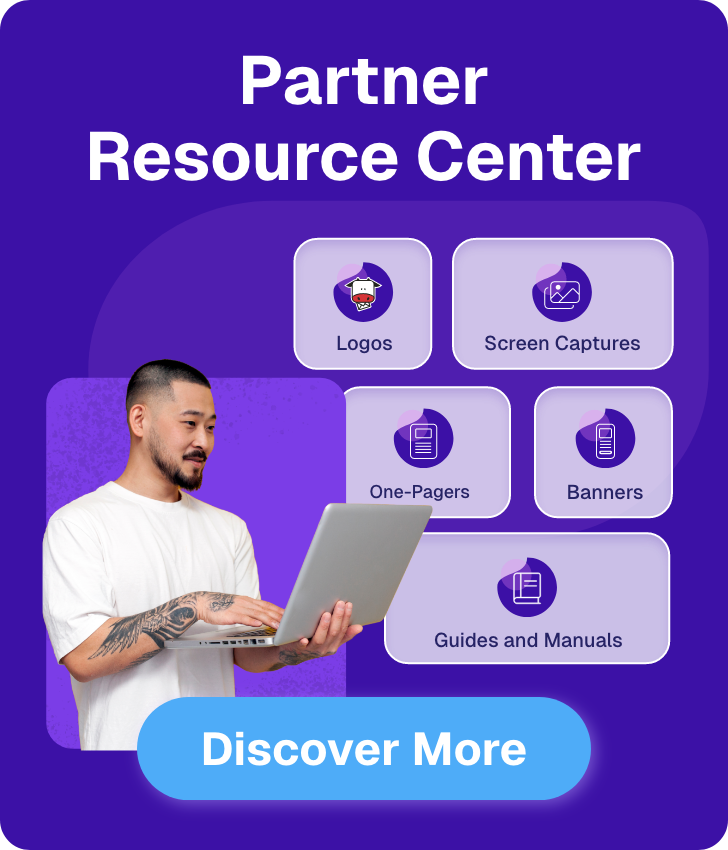

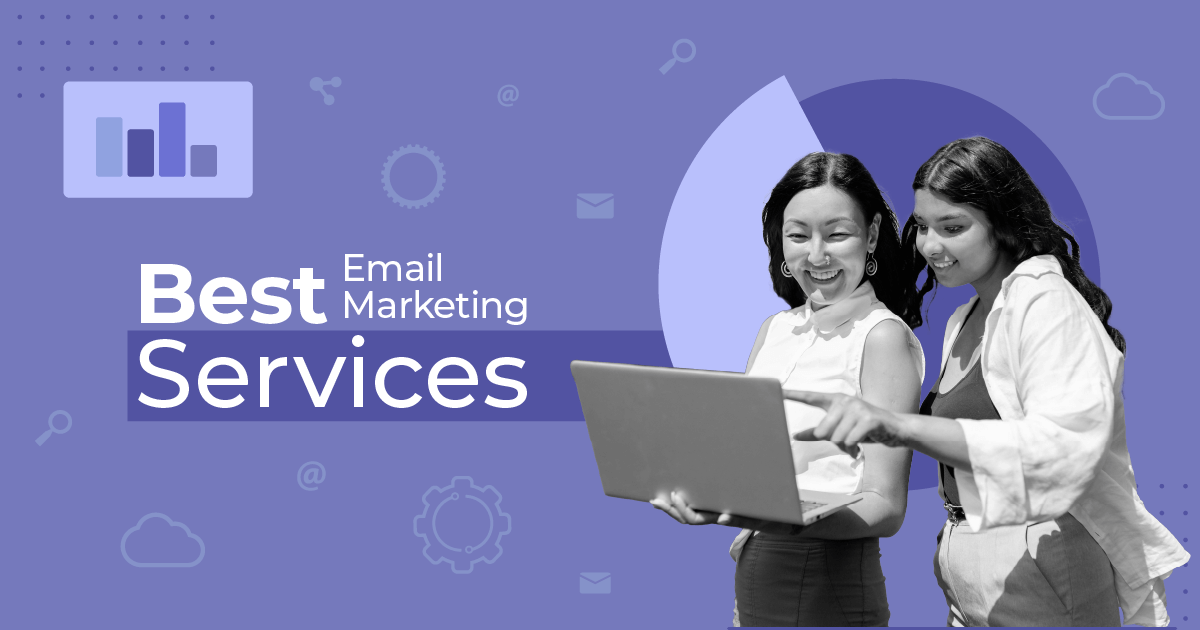
 Published by
Published by
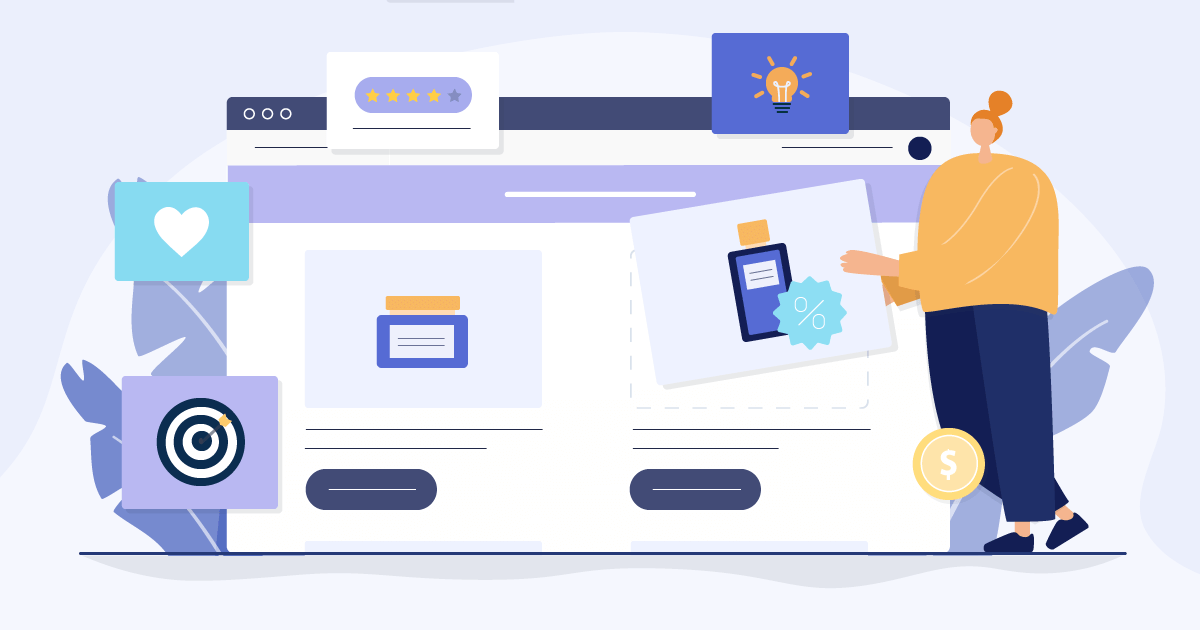

 Published by
Published by